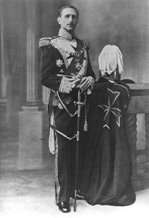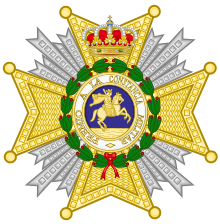Francisco de Borbón y de la Torre
| Francisco de Borbón y de la Torre | |
|---|---|
 Portrait as Grand Master of the Order of Saint Lazarus | |
| Born |
16 January 1882 Madrid, Spain |
| Died |
6 December 1952 (aged 70) Madrid, Spain |
| Spouse | Enriqueta de Borbón y Parade |
| Issue |
Isabella de Borbón Enrique de Borbón Francisco de Borbón y Borbón |
| House | House of Bourbon |
| Father | Francisco de Paula de Borbón y Castellví |
| Mother | Maria Luisa de la Torre |
| Religion | Roman Catholicism |
Francisco de Borbón y de la Torre (Spanish: Francisco de Paula de Borbón y La Torre; 16 January 1882 – 6 December 1952) was a Spanish aristocrat, military officer (Captaincy General) and member of parliament in Spain.
He was a cousin of King Alfonso XIII of Spain. As a military officer, he took part in the Spanish Civil War. He was by marriage the Duke of Seville.
Francisco de Borbón y de la Torre was authorised by his cousin King Alfonso XIII to accept the appointment as Grand Master (1935-1952) of the Order of Saint Lazarus, hence resurrecting the office that had been vacant since 1814 after the 43rd Grand Master, Louis Stanislas Xavier de France, became King Louis XVIII after the Bourbon restoration.
Family
He was the elder son of Francisco de Paula de Borbón y Castellví (1853-1942) and his morganatic wife, Maria Luisa de la Torre (1856-1887). On 21 August 1907, he married his cousin Enriqueta de Borbón y Parade (1885-1967), 4th Duchess of Seville and daughter of Enrique de Borbón y Castellví, 2nd Duke of Seville (1848-1894). From this marriage, three children were born:
- Isabella de Borbón (1908-1974), who married Rinaldo Barucci (1900-1956)
- Enrique de Borbón (1909-1915)
- Francisco de Borbón y Borbón (1912-1995)
Order of Saint Lazarus

Francisco de Borbón y de la Torre was appointed Lieutenant-General of the Order of Saint Lazarus in 1930. Subsequently, on 12 December 1935, he was authorised by his cousin King Alfonso XIII to accept the appointment as Grand Master (1935-1952) of the Order of Saint Lazarus, hence resurrecting the office.
The symbolic value of this appointment was limited, however, by the fact that the Spanish Republic itself dissolved the royal orders in 1933.[1][2][3] The Order of Saint Lazarus in Spain was subsequently officially accepted by the Spanish Republican Government by decree dated 9 May 1940.[4]
Orders, decorations and medals
-
 Grand Cross of the Royal and Military Order of Saint Hermenegild (30 July 1940)[5]
Grand Cross of the Royal and Military Order of Saint Hermenegild (30 July 1940)[5] -
 Grand Cross of the Military Order of Merit (Spain) (29 September 1943)[6]
Grand Cross of the Military Order of Merit (Spain) (29 September 1943)[6]
References
- ↑ Peter Bander van Duren: Orders of Knighthood and Merit. The Pontifical, Religious and Secularised Catholic-founded Orders and their relationship to the Apostolic See
- ↑ Guy Coutant de Saisseval: Les Chevaliers et Hospitaliers de Saint Lazare de Jérusalem de 1789 à 1930
- ↑ Erich Feigl: Der militärische und hospitalische Orden des hl. Lazarus von Jerusalem. Memento. Wien: Kanzleramt des Grosspriorates von Österreich des Ordre Militaire et Hospitalier de Saint-Lazare de Jerusalem 1974
- ↑ Boletin oficial del Estado num. 131 de fecha 10 de mayo de 1940, pg. 3177-3178.
- ↑ BOE Nr. 244 (30. Juli 1940)
- ↑ Nr. 274 (1. Oktober 1943)